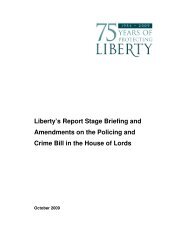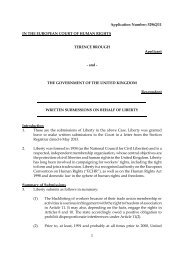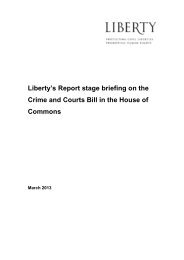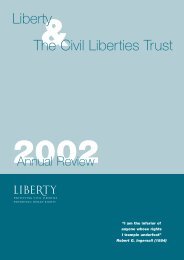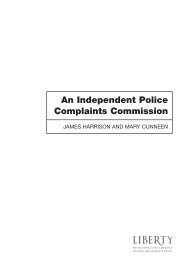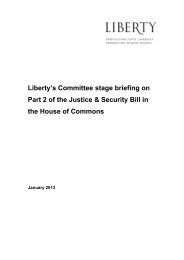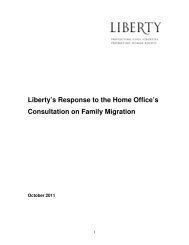Overlooked - Liberty
Overlooked - Liberty
Overlooked - Liberty
You also want an ePaper? Increase the reach of your titles
YUMPU automatically turns print PDFs into web optimized ePapers that Google loves.
<strong>Overlooked</strong>: Surveillance and personal privacy in modern Britain 105<br />
Parliament to provide protection benefiting those subject to unwarranted media intrusion as well as<br />
those who have suffered excessive targeted intrusive surveillance. It is either likely to be so detailed<br />
in providing for appropriate breach, defence and remedy as to be unwieldy, or so broad brush and<br />
overarching as to add little to the existing Article 8 framework. A disparate concept such as privacy<br />
is essentially context-specific. The appropriate legislative and regulatory response to excessive<br />
privacy intrusion is best suited to the specific environment in which that intrusion takes place. For<br />
example, the closest thing there is to a ‘privacy act’ in the UK, the Data Protection Act 1998,<br />
provides regulation specific to data privacy.<br />
Therefore, a piecemeal approach to privacy protection would seem the most sensible option. Having<br />
said this, it is clear that the range and scope of privacy engagement is increasing to an extent where<br />
differing aspects increasing overlap. For example, in the Introduction to Surveillance section, there<br />
were a number of references to growing use of data matching and data mining techniques as a<br />
response to the increasing data processing automation. Data matching techniques are now being<br />
written into legislation such as Part III of the Serious Crime Bill currently before Parliament, while data<br />
mining is increasingly being seen as a legitimate tool identifying potential criminality 210 . Although the<br />
powers in that Bill are limited to use in criminal fraud investigations, it is likely that the uses of data<br />
matching and data mining will expand to cover crime detection generally and possibly into areas<br />
other than the detection and prevention of crime.<br />
At the heart of data matching and data mining is the identification of information that is in some way<br />
anomalous to other information that is being processed. This raises a series of possibilities once such<br />
information has been identified. For example, the process is automated and does not (at least initially)<br />
involve human intervention. Once an ‘incongruous’ data pattern has been established the issue is<br />
how to use the information. The investigating authority will be in an interesting position in relation to<br />
what legitimate action might follow. It is unlikely that there will be sufficient reason to launch a criminal<br />
investigation from a set of unusual data results. Presumably the data received will be one of many<br />
sets that might indicate some form of wrongdoing but equally might be absolutely innocent.<br />
Regardless of whether the powers to take further investigatory action exist, there might be very good<br />
resource and logistical reasons why human input into investigation might initially remain limited.<br />
However, as has been seen in the section on Targeted Surveillance, there were over 439,000<br />
applications for access to Communications Data made under Part I Chapter II of the Regulation of<br />
Investigatory Powers Act 2000. As considered earlier, communications data access is available to<br />
an extremely wide range of public bodies. It can be self-authorised with the only requirements being<br />
that authorisation is in accordance with a range of justifications (including crime detection and<br />
prevention) and if the conduct is proportionate to the aim sought. The throwing up of unusual data<br />
210<br />
As summarised in the Home Office Consultation ‘New Powers against Serious and organised Crime’ –<br />
‘For the purposes of this paper, we see data matching as taking two separate data sets with comparable<br />
information (i.e. both contain the same types of information, for example names) and cross referencing<br />
them to produce matches. These data sets would typically be for mutually exclusive purposes which can<br />
reveal where entitlements are being incorrectly granted, e.g. when the same name appears in connection<br />
with pension payments and a list of deceased persons. Data mining, on the other hand, uses more<br />
advanced software to analyse data in a number of ways. It can be used within data sets to expose fraud,<br />
and is particularly useful when there are many variables within a data set, or the sheer volume of data<br />
means that automated analysis is necessary.’ http://www.homeoffice.gov.uk/documents/cons-2006-<br />
new-powers-org-crime/cons-new-powers-paperview=Binary at page 22



